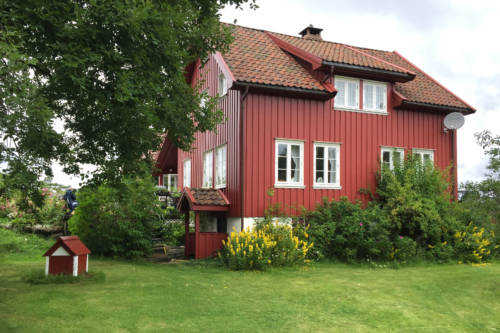
On A Beautiful Island in Norway, Growing Potatoes and Counting Rare Orchids Is The Norm
Imagine this: You’re on an island in the southernmost tip of Norway. You wake up and dive for oysters, pick raspberries in the garden, read books on the back porch with a cup of tea, and soon friends and family are singing folk songs with flowers in their hair to greet the guest-of-honor, Inger Johanne Mørck. This is her home, but she has made every person standing here today feel like they are a part of it. Her island, Fjelldalsøy, is a gardener’s paradise. The soil, which use to be covered by sea water, is inundated with oyster shells and the calcium deposits that come with it. Although much of the year in Norway is defined by cold and dark days, summer is celebrated by all living things— humans and plant life alike.
Each Spring, Mørck prepares the land by shifting the soil, uprooting summer flowers that have died in the winter, and adding fresh soil and chicken pellets as her fertilizer. She then searches for orchids that grow wild on her property and are on the verge of extinction. “We don’t touch them, but count them every year to see how many there are,” she reveals. “Some years there are twenty or thirty orchids, other years there are only ten. But they always come back. I think the soil is special.”
When Mørck purchased the land over 40 years ago, farmers lived on the island with their animals and grew potatoes. Dutiful to the history that informs her garden and home, she has continued this tradition by maintaining the crop every year.
“My daughter-in-law Katrina and I dig them up and make new land for them to grow. Potatoes cannot stay [put] for more than three years in the same soil. They get diseases, so we grow a different kind of crop like kale, beans, or sugar snaps in its place,” she tells me. Then there are her kitchen staples– garlic, onions, parsley, and even stinging nettles, which she uses to make soup. The land also supports plush apple and plum trees. When plums are ripe, Mørck makes her signature jam and syrup, the latter of which she uses as a welcome addition to summer cocktails.
“In Norway, because we have such cold winters, the urge to see flowers and their colors is indescribable. You love that things just come back, like roses. You look at them and can’t believe it.”
Before she was surround by incredible hydrangeas, Easter lilies, daffodils, yellow flowers that grow deep in the soil like weeds, and her favorite plant, the self-seeding feverfew, she watched her step-father grow endives in their cellar. “They don’t like the light. Like asparagus, if they grow out of the soil, they will turn green. You have to cover up the asparagus so that the tip never sticks out of the soil. This is why white asparagus are more expensive. We also grew red bell peppers in the cellar,” she remarks.
Today, whenever Mørck goes to a bookstore or library, she seeks out botanical books because her relationship with nature has become one of her life’s great joys. “In California, you have green right outside your door, all the time,” she notes.
“But in Norway, because we have such cold winters, we love the spring and summer. The urge to see flowers and their colors is indescribable. You love that things just come back, like roses. You look at them and can’t believe it. When the birch trees come out and the birds start to sing, it’s a glorious time. All it takes is one day to go from a mink coat to a pair of shorts.” And with that, we retreat onto the island, her own little botanical paradise.



































